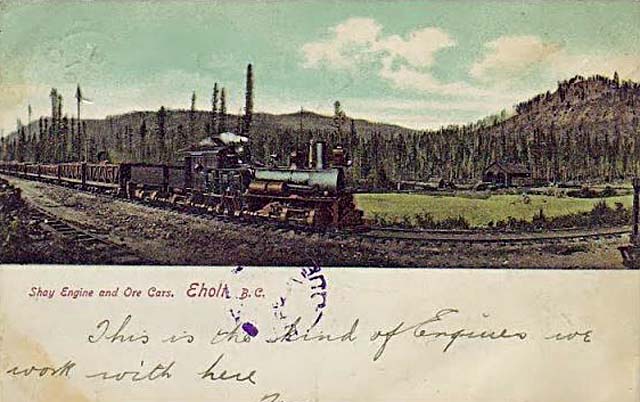|
A Canadian Pacific Shay pulls a string of wooden ore cars - Date/Photographer unknown - Postcard.
2 March 2014
Eholt Was Busy Railway Point
Eholt British Columbia - The old Boundary railway junction of Eholt, 14 kilometres from Greenwood, was named after Louis Eholt
(1840-1911) who had a cattle ranch there next to a creek that also took his name.
He appears to have sold his land to George Rendell in anticipation of the Columbia and Western Railway being built.
The town was first mentioned in the Grand Forks Miner of 10 Dec 1898: "Eholt, Rendell and Co.'s new town in Summit camp, is to have a
hotel."
A week later the paper added: "The new town of Eholt in Summit camp, it is said, will be a hummer."
Frederic Wollaston surveyed the town site in the spring of 1899 and thanks to the Phoenix mines, Eholt became a bustling divisional railway
headquarters.
A post office opened the same year and operated until 1948, although the town's heyday ended in 1912 following a fire that destroyed the CPR's machine shops
and roundhouse.
The facilities were moved to Grand Forks.
Louis Eholt lent his name to two other places but it didn't stick.
In the 1880s, he pre-empted land at present-day Midway, which was first called Eholt's.
An early mention appears in the Victoria Daily Colonist of 23 Jun 1891: "Another seam has been discovered by John Thornton on Mr. Ray's ranch, about
two miles above Eholt's on Boundary creek."
Around 1893, Eholt sold his ranch to R.C. Adams of Montreal, who had a town site laid out that was first called Boundary City and then Midway.
Meanwhile, a portion of West Grand Forks, otherwise known as Columbia, was called Little Eholt in the 1910s, although it's unclear why.
Perhaps it was home to a large number of former Eholters.
Most sources say Louis Eholt was a Luxembourg native, but he was actually born in the Alsace region of France.
According to his obituary in the Colville Examiner, he came to America at 19 and went to California, arriving late in the gold rush.
But he was early into BC when gold was discovered on the Fraser River and ran a pack train and hotel.
He later owned a ranch on Pavilion Mountain, near Clinton, and married Emily Crozer in 1879.
He appears to have come to the Boundary in the 1880s and left around the time his namesake town was established, for he was never listed as a resident
there.
He died in Meyers Falls, Washington, USA, in 1911 at age 71, and is buried alongside an Annie L. Eholt, presumably his second wife, who died the same
year.
He was survived by a stepdaughter, Lillian Bonnett.
Although Eholt is today a ghost town, its site is denoted by a roadside marker.
The word Eholt is also painted on a cement block and a homemade sign along the highway.
Greg Nesteroff.
|

